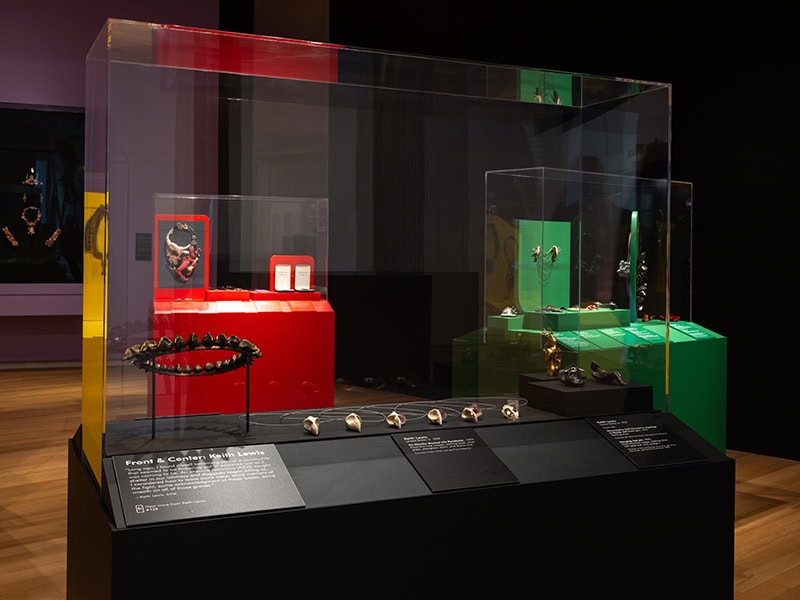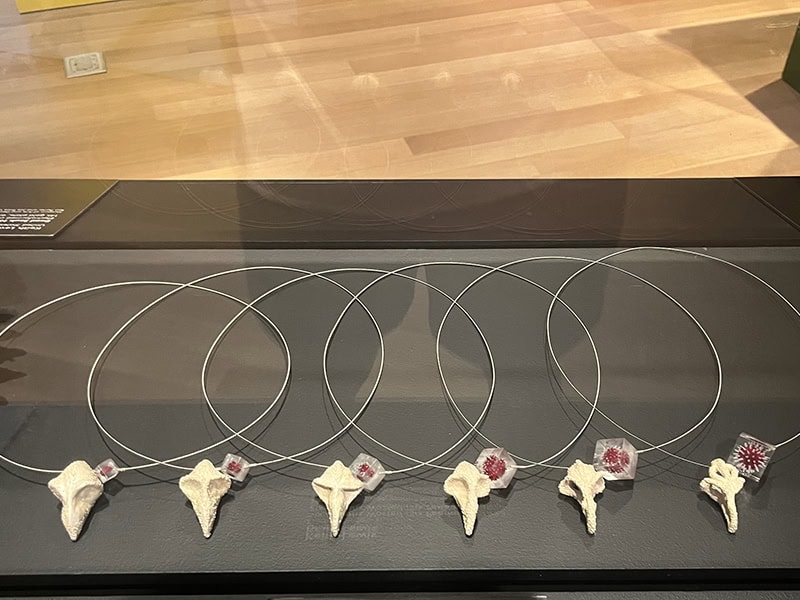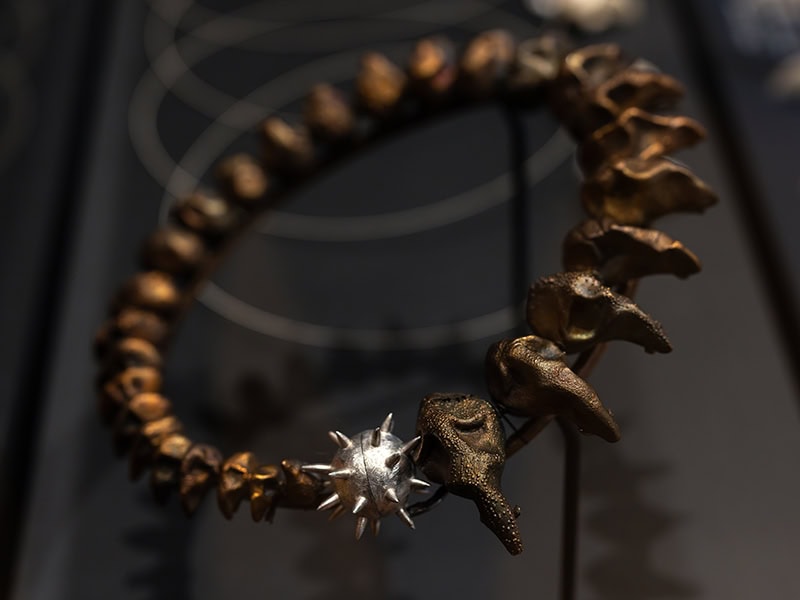OUT of the Jewelry Box
April 20, 2024–April 12, 2026
Museum of Arts and Design, New York, NY, US
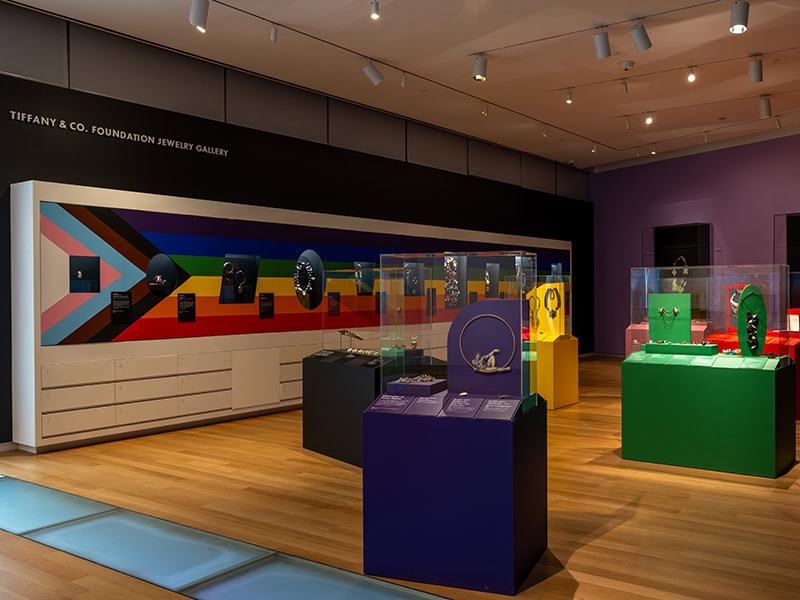
In the second-floor gallery of the Museum of and Arts and Design (MAD), a long, painted pride flag stretches across the wall-mounted display cases, and six pedestals in the center of the room are colored in bright, solid hues. The chances of missing the gallery are slim due to the splashy rainbow display—an iconic, if gimmicky, symbol of queer identity. Pieces made by queer artists are mounted on the wall; The Porter and Price Collection is displayed on the pedestals.
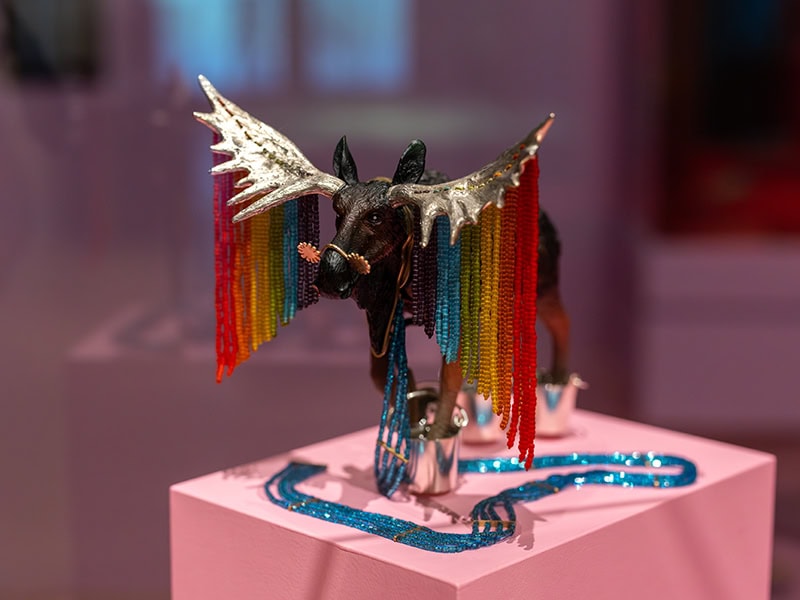
MAD’s “proud” exhibition, OUT of the Jewelry Box, focuses on queer perspectives in contemporary jewelry. Curated by Barbara Paris Gifford, the show spotlights the perspective of Ron Porter and Joe Price, a gay, white married couple from the South who have been collecting jewelry together through their 41-year relationship. They have gifted the 56 works on display from their collection to MAD. In order to include even more diverse voices to represent the queer community, the exhibition also features work by 22 queer artists who were already represented in the museum’s collection.
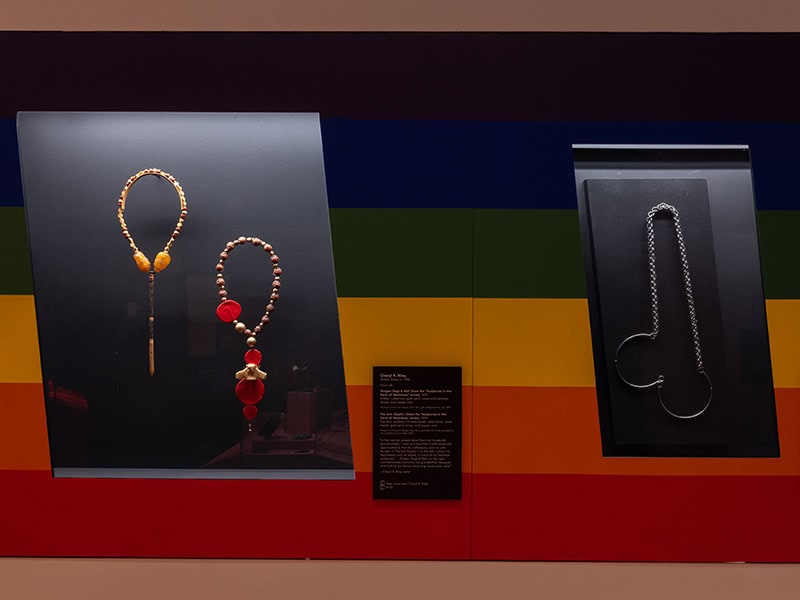
Three things strike me about this exhibition: 1) The structure of the show is confusing because there is not a consistent point of view. 2) Even though it is confusing, I find its shifting gaze to be one of the richest aspects of the display. 3) The show relies heavily on text to discuss identity, which leads me to wonder if or how the objects themselves convey queerness.
The exhibition’s structure
In this display you’ll see two shows in one. There is the work by queer jewelers, each accompanied by an artist statement related to expressing identity through jewelry. This is a familiar format for viewing art.
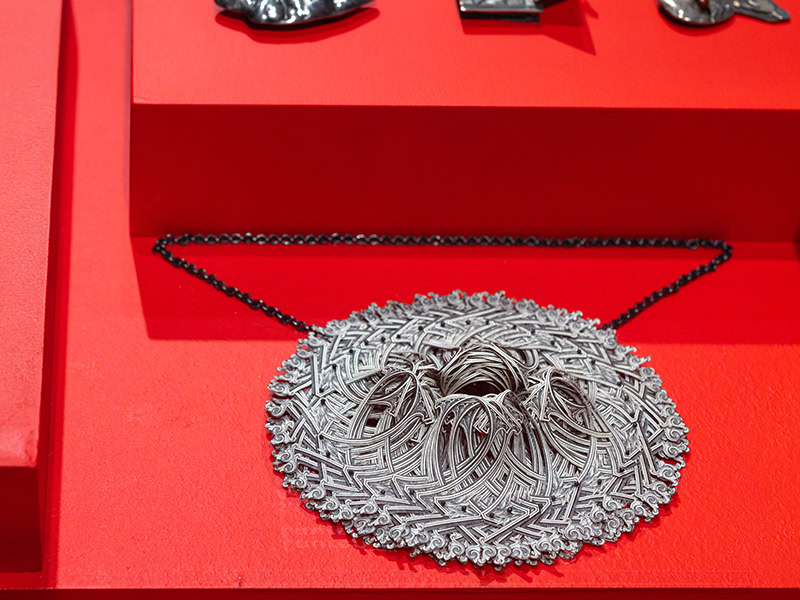
US currency, silver, monofilament, 4 3/4 x 5 3/4 x 1 3/4 inches (121 x 146 x 44 mm), Museum of Arts and Design, New York; gift of the Ron Porter and Joe Price Collection, 2022, shown in OUT of the Jewelry Box, Museum of Arts and Design, New York (April 20, 2024–April 12, 2026), photo: Jenna Bascom, courtesy of the Museum of Arts and Design
The other is the focal point of the show, which is more unusual. Porter and Price’s contribution does not have statements about individual works from the artists. Instead, the pieces are sorted into categories and the collectors reflect upon how each grouping resonates with them as gay men. The work here is largely made by “heteronormative allies” so the shift to the collector’s perspective is necessary to keep with a discussion of queer identity.[1]
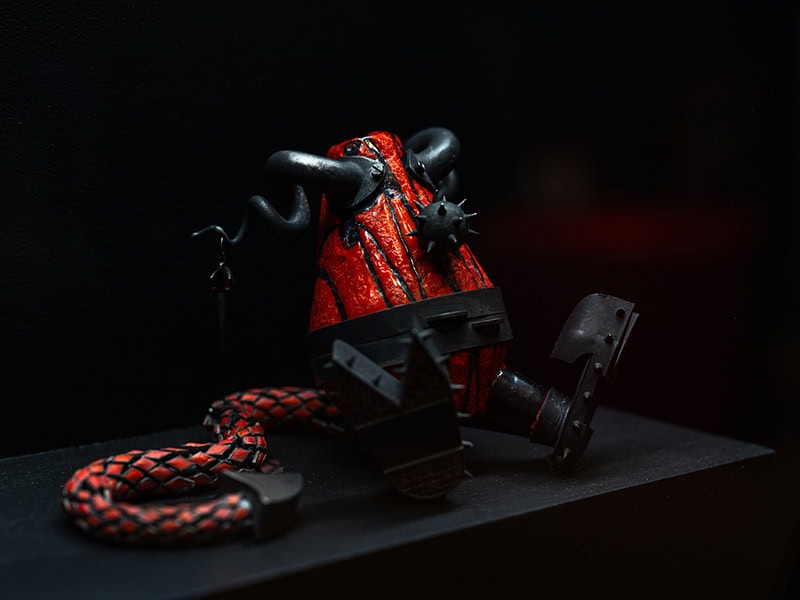
The text does a lot to guide museum-goers in figuring out which lens to view the objects through (collector or artist), and to maintain the throughline of queer identity. Outside of the umbrella of queerness, it takes some mental gymnastics to relate the two components of this show to one another. This distracts from the objects themselves. The exhibition framework leans on the text heavily. Without it, the objects as a group do not have an obvious connection.
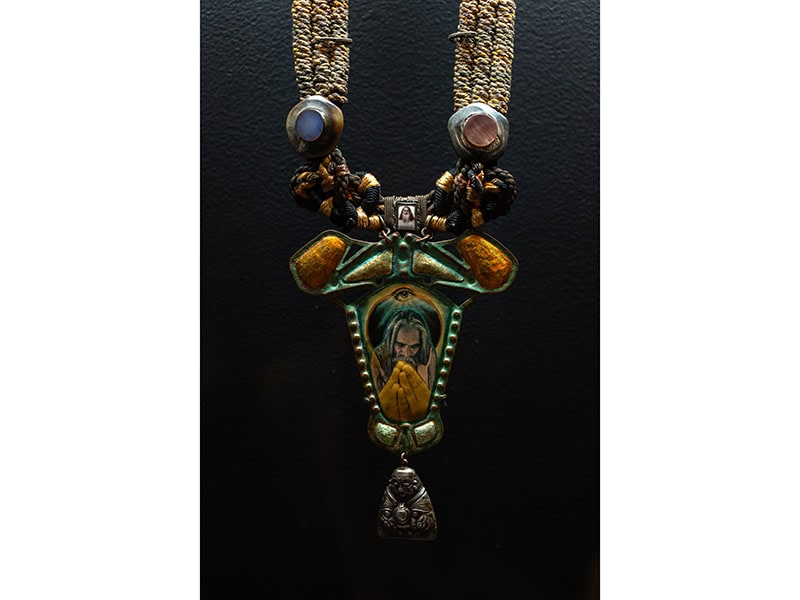
A shifting gaze
Distracting structure aside, I find the shifting perspectives in this exhibition quite powerful. When the rarely public perspective of a collector is at the center of an exhibition, gaze itself becomes the subject. In this show there are places where the artist’s gaze and the collector’s gaze are in dialogue with one another in lively ways. I see this most clearly in the way that Porter and Price and artist Sulo Bee approach the topic of bodies in different ways.
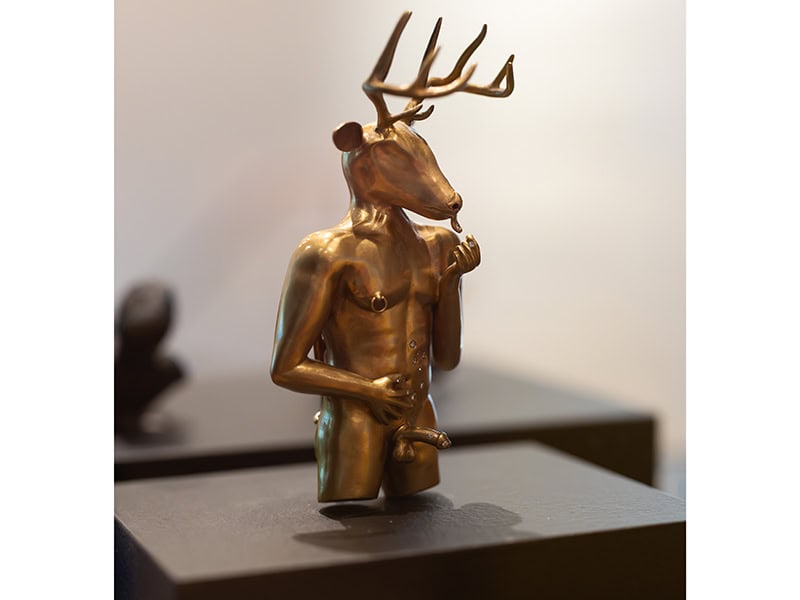
In a category the collectors titled “Affirmations of Queer Desire,” the wall text reads, “As a same-sex couple, we are naturally attracted to the male body and the story it may tell.” Like the collection itself, this contextualization of queerness focuses explicitly on the gaze.
Alternatively, Bee gives us a different take on queer bodies. They describe how their perspective of their environment changed after getting gender-affirming top surgery: “I noticed the queer subtleties in nature and its lack of rigid binaries,” states the artist.[2] Bee’s piece B3TTER_dayz[P4LM_TR33_angel], which hangs on the back wall of the gallery, is a neckpiece as long as a torso. It features large biomorphic hollow forms and sand-encrusted shells. It is not just body adornment, but also an emblem representing how Bee sees themself reflected in their surroundings when they feel comfortable in their skin. From Bee’s perspective, queerness is a lens that lets them see the world in a more nuanced light.
While Porter and Price’s gaze as collectors shows that they find personal resonance in objects that reflect their identity, Bee creates objects as a way of processing how they gaze upon the world. The differing positions of the collectors and maker toward contemporary jewelry are intertwined with other aspects of identity such as generation, race, and class.
The gaze of the museum visitor is not represented in the display, but adds another facet of significance to a show about identity. It made me think how viewers might experience this show differently based on their varying identities. From my own perspective as a queer jeweler, I expected this show to resonate with me more than it did. I related to the ways many of the queer artists expressed themselves with specificity and vulnerability, but found the broadness of both Porter and Price’s texts and the show’s statement difficult to connect with. Left unsure whether queer jewelers are the target audience of this show, a lingering question remains: who is this show for? And what might they see that I have not?
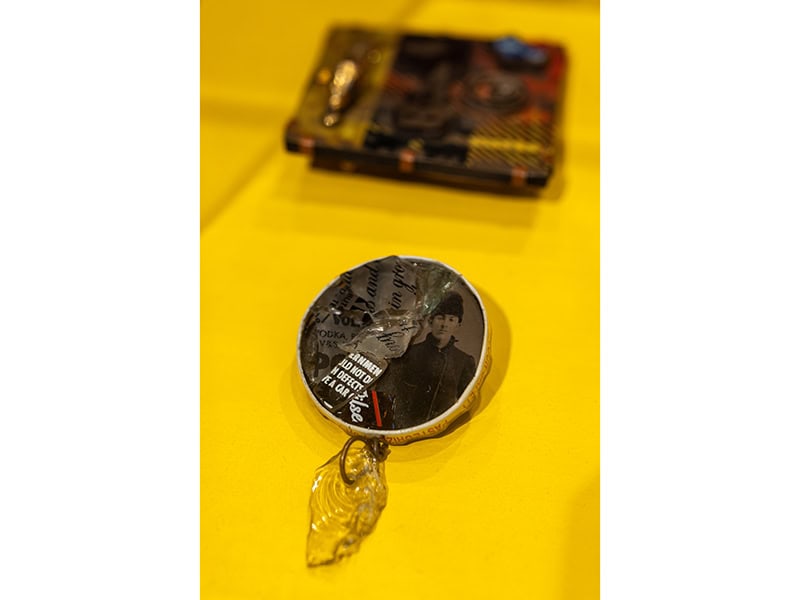
How do objects convey identity?
As I mentioned earlier, the text and the display do a lot of heavy lifting in maintaining the continuity of queer themes throughout this show, but do the objects themselves convey queerness? Keith Lewis’s work stands out from the rest of The Porter and Price Collection because he has the largest number of works on display, and they are the only objects through which an artist speaks for themself. Of his own work Lewis says, “Long ago, I found myself becoming part of a community that seemed to be flickering out of existence … An obscure retrovirus [AIDS] sought shelter in our intimacy and doggedly began killing us … I considered how to leave some trace.”[3]
As gay men, Porter and Price relate to Lewis’s themes of sexual identity and commemoration of loved ones who have died of AIDS. Lewis’s piece Six Months Wasted is a series of six silver-plated beaked skulls, each hanging on a circular necklace of piano wire. Next to each skull hangs an acrylic cube encasing a red spiky ball that represents the AIDS virus. The diseased cube increases in size from the first to the sixth necklace as the skulls become more skeletal, as if decaying. Lewis’s work is visceral, direct, and at times hard to look at. His experience of grappling with mortality, fear, and otherness as a gay man living through the AIDS crisis is portrayed in his pieces with excruciating clarity. They are undeniably queer objects.
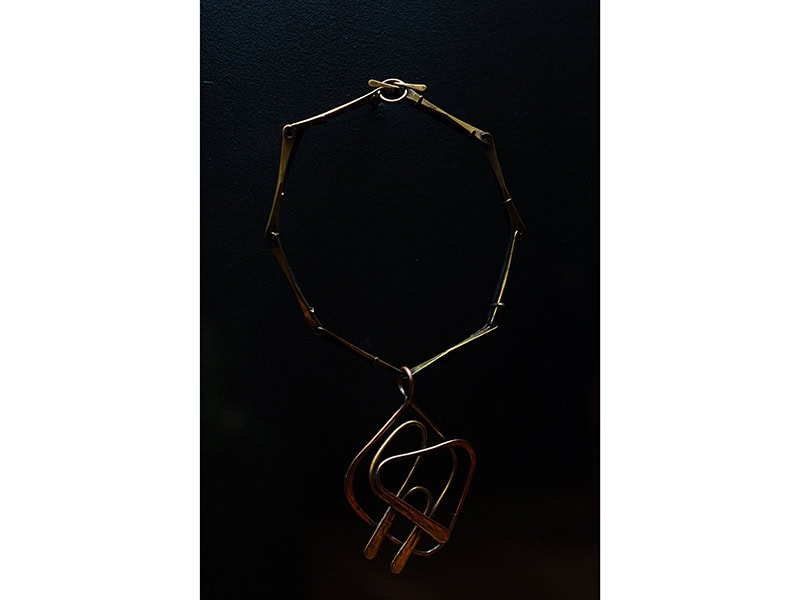
Conversely, Art Smith’s pieces, hanging on the wall, stand out because they are not explicitly queer objects. Smith, who was a Black gay jeweler in the 1950s, was known for his bold designs and technical skill. The two neckpieces displayed in this exhibition feature his signature forged wire, mixed metals, and sense of movement and depth using positive and negative space. He was not a jeweler who made work about his identity, but his identity contributed to the work he made. For instance, Smith worked in a classic mid-century style, but his use of volume, shape, and layering are elements that also evoke body adornment seen throughout the African diaspora, and it reflects his Afro-Caribbean heritage.
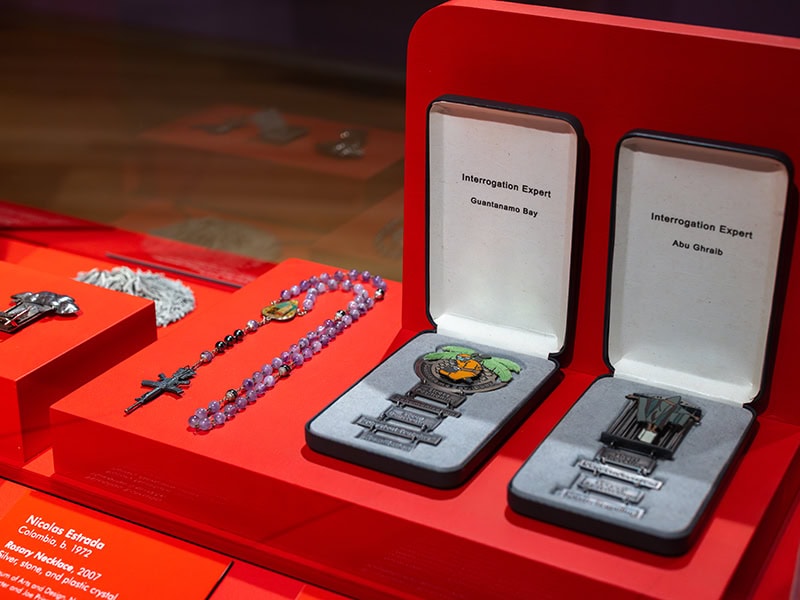
Identity can be expressed through art both explicitly and implicitly. Even though many of the works from The Porter and Price Collection do not convey queerness because they are not made by queer artists, they still each convey the identities of the makers in unique ways. For example, many pieces in the section titled “Contemporary Issues and Events” use recognizable imagery to convey personal experience related to race, addiction, and religion. On the other hand, the “Wondrous Forms” section displays work that is abstract. The pieces implicitly convey identity because each artist’s perspective is shaped by their personal experiences, which inherently influences the work they make.
To me, queerness is, as bell hooks so eloquently describes, “about the self that is at odds with everything around it and that has to invent and create and find a place to speak and to thrive and to live.”[4] In other words, queerness is a bittersweet freedom to build one’s own world from scratch after realizing that being a full human transcends rigid systems and categorization. OUT of the Jewelry Box tries to establish coherence by creating systems of sorting perspectives and styles of expression, but it ultimately causes confusion. The exhibition’s failure to deliver clarity is unintentionally what makes it truly queer.
Editor’s note: Out of the Jewelry Box is accompanied by the catalog Craft Front & Center: Out of the Jewelry Box as well as audio recordings of personal stories by the show’s queer artists.

[1] Quote from the exhibition’s wall text.
[2] Barbara Paris Gifford, Craft Front and Center: OUT of the Jewelry Box (New York: Museum of Arts and Design, 2024), 75.
[3] Quote from the exhibition display.
[4] Bell Hooks – Are You Still a Slave? Liberating the Black Female Body | Eugene Lang College, 2014. 1:27:40
We welcome your comments on our publishing, and will publish letters that engage with our articles in a thoughtful and polite manner. Please submit letters to the editor electronically; do so here.
© 2024 Art Jewelry Forum. All rights reserved. Content may not be reproduced in whole or in part without permission. For reprint permission, contact info (at) artjewelryforum (dot) org

![Sulo Bee (United States, b. 1993), B3TT3R_dayz [P4LM_TR33_angel], 2023, brass, copper, fine silver, sterling silver, steel, epoxy, enamel paint, rubber, Caspar Beach sand, found seashells, 26 x 18 x 2 inches (660 x 457 x 51 mm), Museum of Arts and Design, New York; purchase with funds provided by the Collections Committee, 2023, shown in OUT of the Jewelry Box, Museum of Arts and Design, New York (April 20, 2024–April 12, 2026), photo: Jenna Bascom, courtesy of the Museum of Arts and Design](https://metal9.buzz/wp-content/uploads/2024/11/1732800987_146_Perspective-and-Queer-Objects-Art-Jewelry-Forum.jpg)
![Sulo Bee (United States, b. 1993), B3TT3R_dayz [P4LM_TR33_angel], 2023, brass, copper, fine silver, sterling silver, steel, epoxy, enamel paint, rubber, Caspar Beach sand, found seashells, 26 x 18 x 2 inches (660 x 457 x 51 mm), Museum of Arts and Design, New York; purchase with funds provided by the Collections Committee, 2023, shown in OUT of the Jewelry Box, Museum of Arts and Design, New York (April 20, 2024–April 12, 2026), photo: Jenna Bascom, courtesy of the Museum of Arts and Design](https://metal9.buzz/wp-content/uploads/2024/11/1732800987_610_Perspective-and-Queer-Objects-Art-Jewelry-Forum.jpg)
